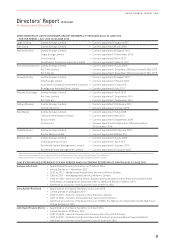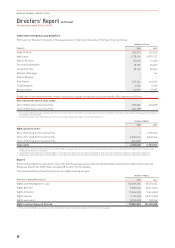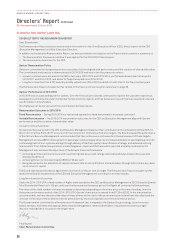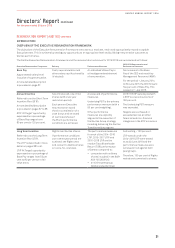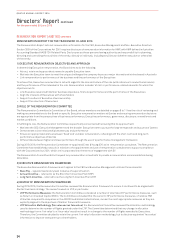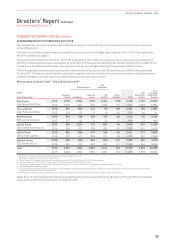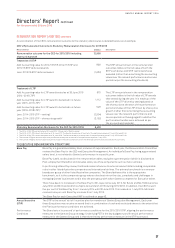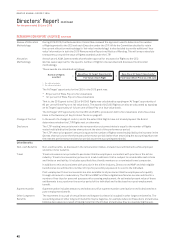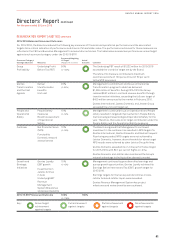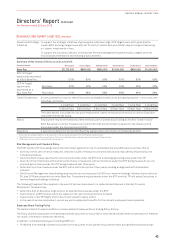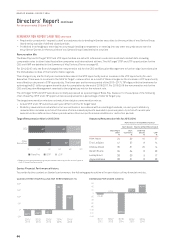Qantas 2016 Annual Report Download - page 36
Download and view the complete annual report
Please find page 36 of the 2016 Qantas annual report below. You can navigate through the pages in the report by either clicking on the pages listed below, or by using the keyword search tool below to find specific information within the annual report.
Directors’ Report continued
For the year ended 30 June 2016
REMUNERATION REPORT (AUDITED) CONTINUED
REMUNERATION REPORT FOR THE YEAR ENDED 30 JUNE 2016
The Remuneration Report sets out remuneration information for the CEO, Executive Management and Non-Executive Directors.
Section 300A of the Corporations Act 2001 requires disclosure of remuneration information for KMP, with KMP defined in Australian
Accounting Standard AASB 124 Related Party Disclosures as those persons having authority and responsibility for planning,
directing and controlling the activities of the entity, directly or indirectly, including any Director (whether executive or otherwise)
ofthat entity.
1) EXECUTIVE REMUNERATION OBJECTIVES AND APPROACH
In determining Executive remuneration, the Board aims to do the following:
–Attract, retain and appropriately reward a capable Executive team
–Motivate the Executive team to meet the unique challenges the company faces as a major international airline based in Australia
–Link remuneration to performance of the business and the performance of the Executives
To achieve this, Executive remuneration is set with regard to the size and nature of the role (with reference to market benchmarks)
and the performance of the individual in the role. Remuneration includes ‘at risk’ or performance-related elements for which the
objectives are to:
–Link Executive reward with Qantas’ business objectives, financial performance and the performance of the Executives
–Align the interests of Executives with shareholders
–Support a culture of Executive share ownership
–Support the retention of Executives
2) ROLE OF THE REMUNERATION COMMITTEE
The Remuneration Committee (a Committee of the Board, whose members are detailed on pages 8 to 11 has the role of reviewing and
making recommendations to the Board on specific Executive remuneration matters at Qantas and ensuring remuneration decisions
are appropriate from the perspectives of business performance, Executive performance, governance, disclosure, reward levels and
market conditions.
In fulfilling its role, the Remuneration Committee is specifically concerned with ensuring that its approach will:
–Motivate the CEO, Executive Management and the broader Executive team to pursue the long-term growth and success of Qantas
–Demonstrate a clear relationship between pay and performance
–Ensure an appropriate balance between ‘fixed’ and ‘variable’ remuneration, reflecting both the short-term and long-term
performance objectives of Qantas
–Differentiate between higher and lower performers through the use of a performance management framework
During 2015/2016, the Remuneration Committee re-appointed Ernst & Young (EY) as its remuneration consultant. The Remuneration
Committee has established protocols in relation to the appointment and use of remuneration consultants to support compliance
with the Corporations Act 2001, which are incorporated into the terms of engagement with EY.
The Remuneration Committee did not request any remuneration consultants to provide a remuneration recommendation during
2015/2016.
3) EXECUTIVE REMUNERATION FRAMEWORK
The Executive Remuneration Framework as it applies to the CEO and Executive Management contains three elements:
–Base Pay – a guaranteed salary level inclusive of superannuation
–Annual Incentive – referred to as the Short Term Incentive Plan (STIP)
–Long Term Incentive – referred to as the Long Term Incentive Plan (LTIP)
4) REVIEW OF REMUNERATION FRAMEWORK
During 2015/2016, the Remuneration Committee reviewed the Remuneration Framework to ensure it continued to be aligned with
Qantas’ business strategy. The review focused on LTIP, in particular:
–LTIP Performance Measures: the Remuneration Committee considered a number of alternate LTIP performance measures, such
as Return on Invested Capital (ROIC). The Committee concluded that the current LTIP performance measures, of relative TSR
of Qantas compared to companies in the ASX100 and Global Listed Airlines, remain the most appropriate measures as they are
explicitly aligned to the objectives of Qantas’ Financial Framework.
–LTIP Allocation Methodology (fair value versus face value): the Remuneration Committee reviewed the allocation methodology
used to determine the number of Rights granted under the LTIP. The Committee determined that any change in allocation
methodology from a ‘fair value’ to a ‘face value’ would not result in a change to the number of Rights awarded to Executives.
Therefore, the Committee decided to retain the current ‘fair value’ allocation methodology, but to disclose equivalent ‘face value’
information to improve transparency to shareholders.
34
QANTAS ANNUAL REPORT 2016





